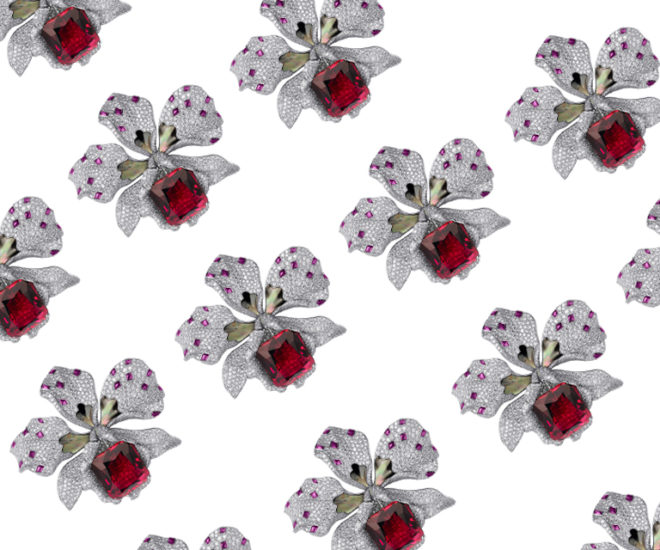Jewelery Guide 2: Tourmaline
With the gem’s recent stratospheric rise in popularity and esteem with jewelers, it is high time to showcase its illustrious history and bedazzling beauty.

Over the past weekend, we took a journey into discovering ruby’s royal sibling, Spinels. Today, we look at another historically rich and bedazzaling beauty, the Tourmaline.
As mentioned in our Jewelry Guide Part 1, finding showpieces featuring spinels and tourmalines in fine jewelry stores and major international maisons would have been difficult a decade ago. In the past five years, however, the tides have changed.
Esteemed fine jeweler Caratell is one local firm that has featured spinels and tourmalines strongly, and imaginatively as three-dimensional art pieces, in its recent collections. With insight from Caratell’s managing director Michael Koh, also a jewelry designer and trained craftsman with over 20 years of experience in the trade, we break down the various factors that make the terrific twosome so appealing and worth your money.
Today, we bring you the Treasure of the Orient, Tourmalines. So join us on the journey and who knows, you may walk away with a new appreciation for the gem.
The Brief
Tourmaline has a hardness of 7 to 7.5 on the Mohs scale, and occurs in a wide array of hues, including pink, blue, green, red, brown, and orange. The gemstone derives its name from the Sinhalese language, and means “mixed gems”. What’s most interesting about tourmaline, according to Koh, is that it may exhibit bi- or even tri-colors (called watermelon tourmaline), and the cat’s eye phenomenon.
There are several main varieties of tourmalines. “The most expensive and valuable is the neon-blue Paraiba tourmaline, which was first discovered in the Brazilian state of Paraiba in 1989. With its unique color and neon effect that is unlike any other gemstone, the Paraiba tourmaline became extremely popular in a very short time due to low supply, and prices soon rocketed sky high. Fortunately, a new mine was found in Mozambique in early 2000, producing Paraiba-like tourmalines with the same properties as the Brazilian ones,” says Koh.
The rubellite, which displays a lush pink or rich crimson, is another beloved variety. It is distinguished from other red and pink tourmalines by the way it behaves in daylight and artificial light – it holds its color when the light source is changed. The indicolite is a variant that displays a light to dark saturated blue, while chrome tourmaline has an intense emerald green hue.
Apart from Brazil, important deposits of tourmaline are found in Afghanistan, Pakistan, Russia, Burma, Sri Lanka, the U.S., Madagascar, Namibia, Mozambique, Tanzania, and Nigeria.
The Jeweler’s Take
“This is a fun stone for jewelry designers to play with, as it comes in all sizes, shapes, and colors. With an excellent cut, it can exhibit maximum brilliance. The most popular are the Paraiba and rubellite, followed by indicolite and chrome,” says Koh.
The History
Tourmaline may be seen as an up-and-coming stone in general, but it is historically much revered by the Chinese. Explains Koh, “Empress Dowager Ci Xi of the Qing Dynasty was a fan of pink tourmalines; vast quantities were shipped from overseas to be created into exquisite jewelry and snuff bottles for her. It was said that, on her deathbed in 1908, she demanded a pink tourmaline from the Pala mine in southern California to be placed on her finger. There is also a beautiful story of how Ci Xi loved a pair of watermelon tourmaline earrings so much that she wore it everyday. It was buried with her, but unfortunately her tomb was robbed.”
In addition, he says that the Chinese have used tourmaline to carve and engrave figures for centuries. Some are even still on display in museums, which is a testament to the durability of the stone. The culture also has an especially strong affinity with the rubellite, as it is an auspicious color and said to be able to ward off evil.
The Insider’s Tip
According to Koh, it is always nice to own a Paraiba, but many do not understand that a good one has to have that radiant, neon glow that is caused by a high concentration of copper. Not all tourmalines from Paraiba have the said effect, and that factor affects the price. “In fact, 95 per cent of Paraiba tourmalines are heat-treated to remove any red coloring caused by the presence of manganese. It is rare to find one blue Paraiba that is not heat-treated and yet emit the neon effect,” he adds.
Story Credits
By Yanni Tan
This article was originally published in the 2015 issue of WOW Jewellery. The featured image, showcases Cartier Caresse d’Orchidées par Cartier rubelite and diamond brooch.







